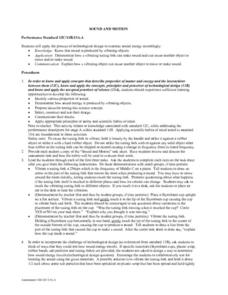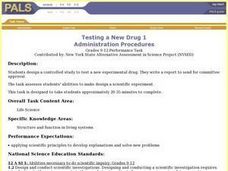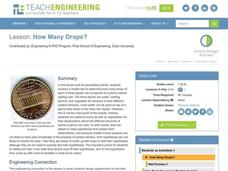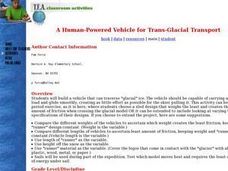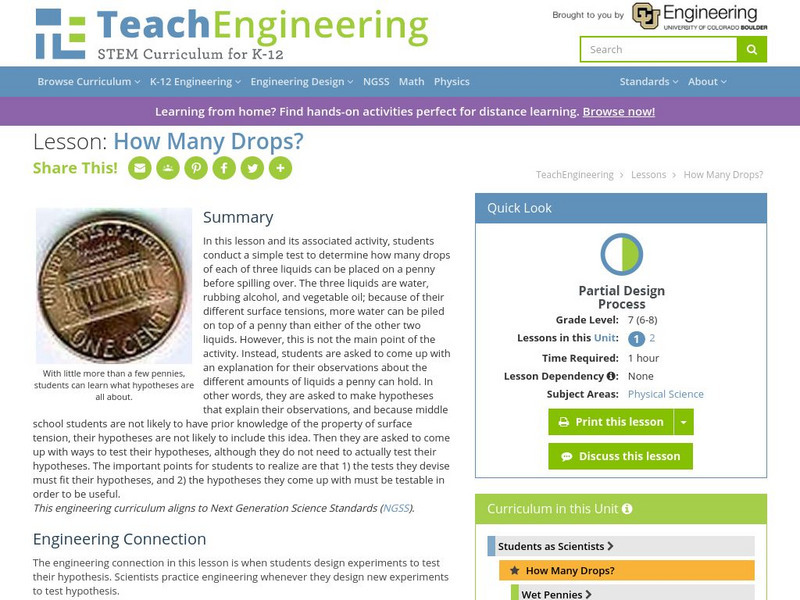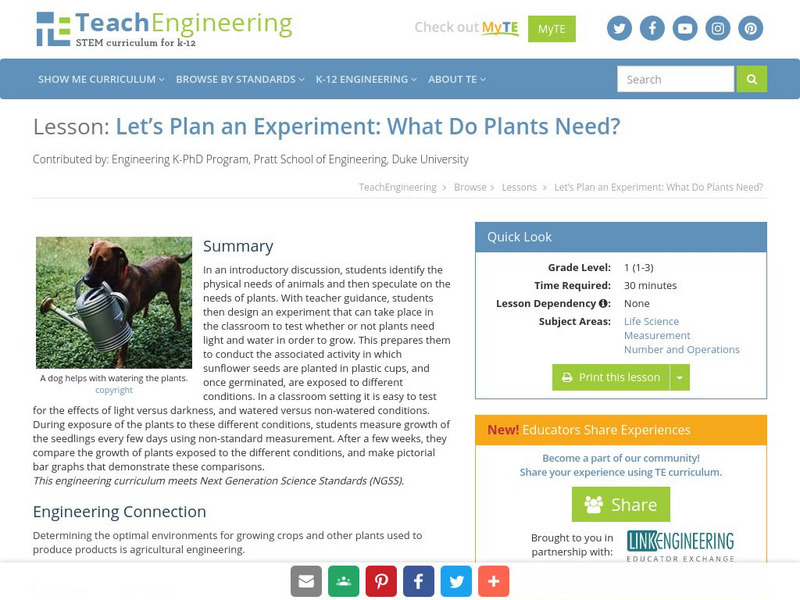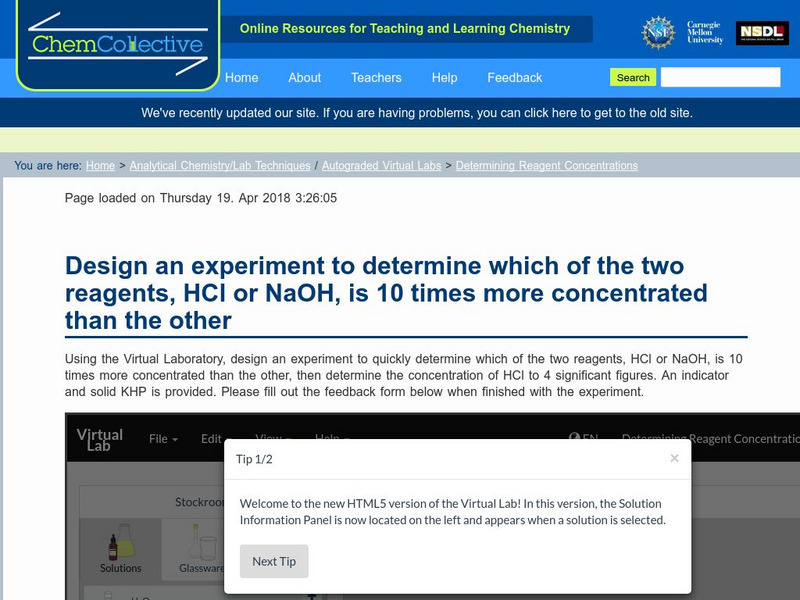Curated OER
Sound And Motion
Students investigate the concept of sound and vibration. They use a tuning fork to make an observation. Students then propose the ideas of different experimental designs to test the concept. The ideas are constructed and then tested.
Curated OER
Changing Ramp Heights
Learners conduct an experiment to determine how the change in ramp height affects the distances a ball is able to move a stationary cup. Data is collected from several trials and recorded and analyzed.
Curated OER
Friction of a Block Weight
Fifth graders hypothesize and design an experiment to study the relationship between a block weight and the number of washers it takes to pull a block across various surfaces. Students graph results and apply their findings to a...
Curated OER
Density and Buoyancy Experimental Design
Students must plan, design, and conduct an experiment that answers the scientific question: "Come up with a question that addresses the factors (variables) of the water and its effect on whether an object floats or sinks."
Curated OER
Aluminum Foil Boats
Young scholars design a boat of aluminum foil and calculate the density of the boat. Washers are added to the boat until it sinks. Students then redesign boat to hold more washers and recalculate the new density.
Curated OER
Testing a New Drug 1
Students act as chief research scientists with the responsibility of testing a new drug. Students design a controlled experiment to test a hypothetical experimental drug. Students write a clear, concise, and detailed plan to present to a...
Curated OER
Every Breath You Take
Students study acids and bases and the uses of indicators. They interpret the actions of an indicator to conclude that bromothymol blue turns yellow in the presence of a weak acid.
Curated OER
How Many Drops?
Seventh graders hypothesize about the number of drops of liquid that can be placed on a penny before it spills over. They examine both the concept of devising a hypothesis and the idea of surface tension. They determine the difference...
Curated OER
Apologia Gen Sci 3 Word Search Puzzle
In this science activity, students look for the words that are related to the theme of the activity. They also work on the skills of spelling and word recognition.
Curated OER
The Lepidoptera Project
Students are introduced to Scientific Inquiry and discover how to design an experiment that answers critical questions using butterflies as the topic. They design experiments that compare the number of species of butterflies in a vacant,...
Curated OER
Living in Extreme Environments
Students explore the living conditions needed to grow bacteria. They develop an experiment that will test the ability of bacteria to survive various temperature extremes. In addition, they complete a lab reprt to share their results.
Curated OER
A Human-Powered Vehicle for Trans-Glacial Transport
Pupils practice problem solving skills and experimental design. They build a vehicle that can traverse "glacial" ice capable of carrying a specific load and glide smoothly, creating as little effort as possible for the skier pulling it....
Curated OER
Who Needs What?
Students identify the physical needs of animals and if plants need the same things as animals. They conduct an experiment to see if plants need light and water to grow. They compare the growth of the plants exposed to the different...
Curated OER
Organs to Go...
Young scholars explain the principles of experimental design and reinforce the steps of the scientific method. Each group of students create a "slush" type mixture to store a chicken liver.
TeachEngineering
Teach Engineering: Does Your Chewing Gum Lose Its Flavor?
In the first part of the activity, each student chews a piece of gum until it loses its flavor, and then leaves the gum to dry for several days before weighing it to determine the amount of mass lost. This mass corresponds to the amount...
TeachEngineering
Teach Engineering: How Many Drops?
In this lesson and its associated activity, students conduct a simple test to determine how many drops of each of three liquids can be placed on a penny before spilling over. The three liquids are water, rubbing alcohol, and vegetable...
TeachEngineering
Teach Engineering: Who Needs What?
The teacher leads a discussion in which young scholars identify the physical needs of animals, and then speculate on the needs of plants. With guidance from the teacher, the students then help design an experiment that can take place in...
CK-12 Foundation
Ck 12: Biology: Science Experiments
[Free Registration/Login may be required to access all resource tools.] Covers the scientific experimental design.
Annenberg Foundation
Annenberg Learner: Against All Odds: Experimental Design
Video program explains the difference between observation and experiment and the principles of experiment design. Lesson draws on real-life example of heart disease study and a double-blind experiment. [28:39]
Chemistry Collective
Chem Collective: Determining Reagent Concentrations
Using the Virtual Laboratory, design an experiment to quickly determine which of the two reagents, HCl or NaOH, is 10 times more concentrated than the other.
Chemistry Collective
Chem Collective: Exploring Oxidation Reduction Reactions
Design an experiment to order Cu, Mg, Zn and Pb from strongest to weakest reducing agent.
TeachEngineering
Teach Engineering: Students as Scientists
This curricular unit contains two lessons that let students actually do the work of scientists as they design their own experiments to answer questions they generate. In the first lesson and its associated activity, students conduct a...
Other
U. Of Wisconsin: Formulating Statistical Questions and Collecting Data
This slideshow gives a detailed explanation of the characteristics of statistical questions and how they differ from other types of questions, the types of studies, and the methods for collecting data. It describes the case of Clever...
Cornell University
Cornell University: Study Design Tutorial: Cross Sectional Studies
This tutorial from Cornell University's College of Veterinary Medicine explains what a cross-sectional study is, its key characteristics, how to assess events and outcomes, and some special considerations when choosing sample...


